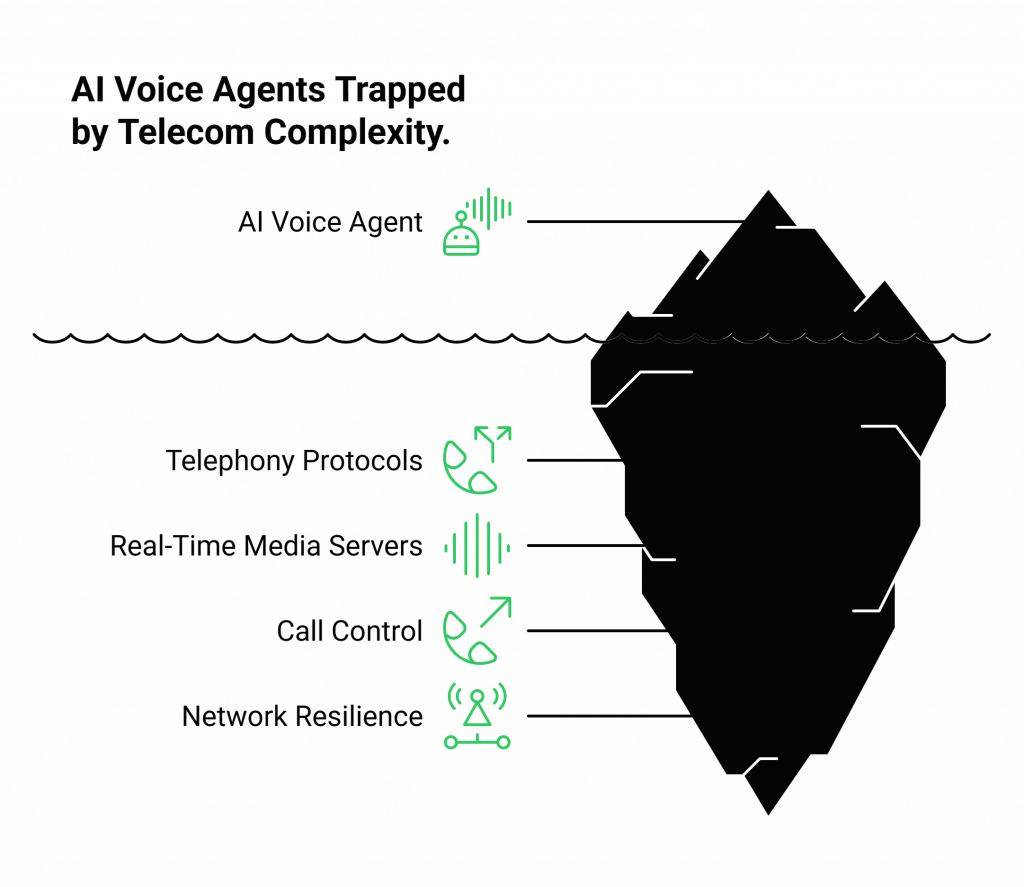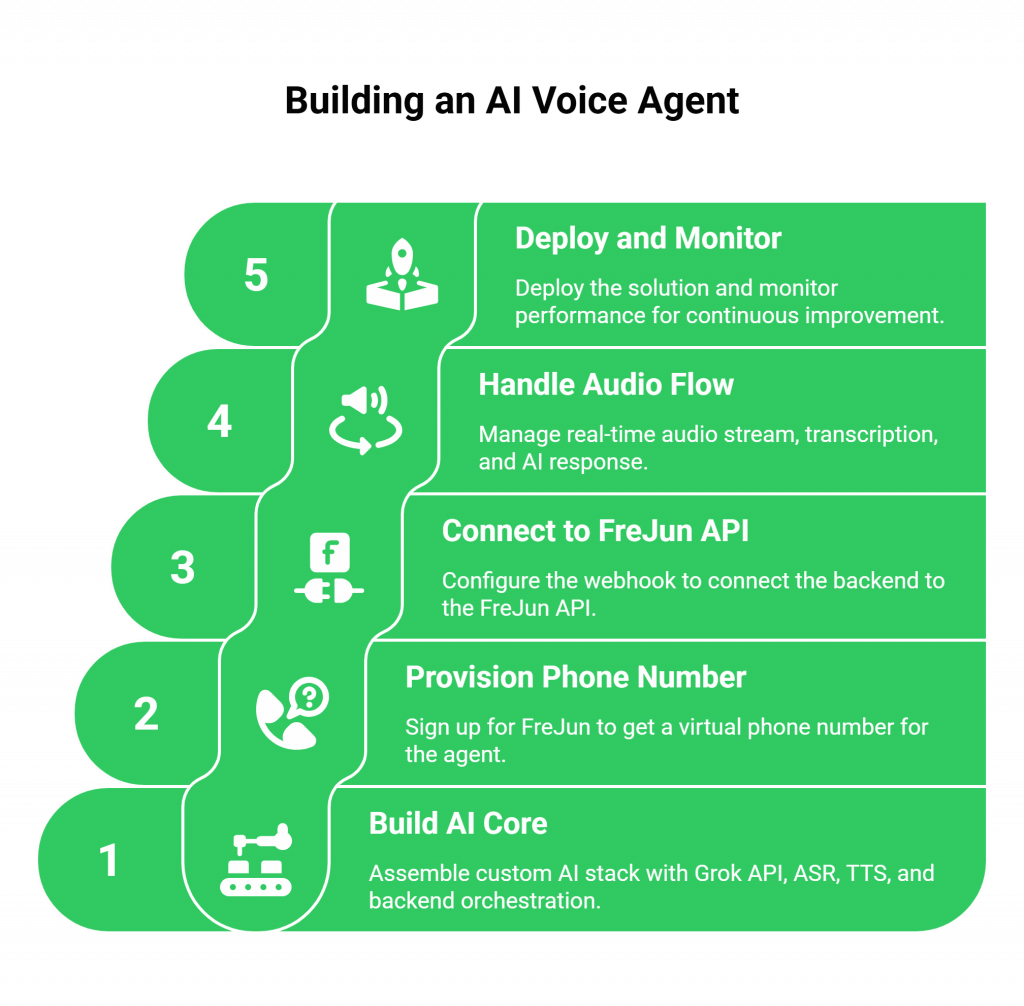The world of conversational AI is being reshaped by a new generation of powerful, personality-infused models. At the forefront of this movement is xAI’s Grok, a model that brings a unique blend of reasoning, real-time data access, and a witty conversational style to the table. For developers, the opportunity to build AI voice agents using xAI Grok represents a new frontier of creativity and control. You can now build a bot that is not just intelligent, but also engaging and genuinely useful.
Table of contents
- What Makes xAI Grok a Great Choice for Voice Agents?
- The Hidden Challenge: A Brilliant Bot Trapped in Your Terminal
- FreJun: The Voice Infrastructure Layer for Your Grok Agent
- DIY Telephony vs. A FreJun-Powered Agent: A Strategic Comparison
- Step-by-Step Guide: How to Build a Complete AI Voice Agent
- Best Practices for a Flawless Implementation
- Final Thoughts
- Frequently Asked Questions (FAQ)
The path to creating this AI “brain” is becoming increasingly clear, with OpenAI-compatible APIs and frameworks like Agno simplifying development. However, after the initial success of building this intelligent core, many teams run into a formidable and often project-killing roadblock. Their brilliant, custom-built creation is trapped, unable to connect to the most critical channel for any real-world business application: the telephone network.
What Makes xAI Grok a Great Choice for Voice Agents?
Building AI voice agents using xAI Grok offers a distinct advantage, particularly for applications that require more than just canned responses. Grok is designed to be a true agent. Key features include:
- Powerful Reasoning and a Unique Voice: Grok is known for its ability to handle complex reasoning tasks and for its distinct, often humorous, personality, which can be leveraged to create a more engaging user experience.
- Real-Time Data Access through Tool Use: This is Grok’s superpower. It has a native ability to use tools, such as web search, to access up-to-the-minute information. This means your voice agent isn’t limited to its training data; it can answer questions about current events, look up financial data, or check the weather in real time.
- OpenAI-Compatible API: Grok is accessible via an API that is compatible with OpenAI’s standards, making it easy for developers who are already familiar with the ecosystem to get started quickly.
The Hidden Challenge: A Brilliant Bot Trapped in Your Terminal
You have successfully built your custom AI stack. Your Grok-powered agent is witty, intelligent, and can pull live data from the web. It works perfectly when you interact with it via a command line or a simple web interface. Now, it’s time to put it to work. Your business needs it to handle the customer support hotline, qualify sales leads, or automate appointment booking over the phone.

This is where the project grinds to a halt. The problem is that the entire ecosystem of tools used to build your bot, the Grok API, frameworks like Agno, and even other AI services for speech recognition and synthesis, is designed to process data, not to manage live phone calls. To connect your custom-built agent to the Public Switched Telephone Network (PSTN), you would have to build a highly specialized and complex voice infrastructure from scratch. This involves solving a host of non-trivial engineering problems:
- Telephony Protocols: Managing SIP (Session Initiation Protocol) trunks and carrier relationships.
- Real-Time Media Servers: Building and maintaining dedicated servers to handle raw audio streams from thousands of concurrent calls.
- Call Control and State Management: Architecting a system to manage the entire lifecycle of every call, from ringing and connecting to holding and terminating.
- Network Resilience: Engineering solutions to mitigate the jitter, packet loss, and latency inherent in voice networks that can destroy the quality of a real-time conversation.
Suddenly, your AI project has become a grueling telecom engineering project, pulling your team away from its core mission of building an intelligent and effective bot. Your custom AI voice agents using xAI Grok are trapped.
FreJun: The Voice Infrastructure Layer for Your Grok Agent
This is the exact problem FreJun was built to solve. We are not another AI model or a closed ecosystem. We are the specialised voice infrastructure platform that provides the missing layer, allowing you to connect your custom AI voice agents using xAI Grok to the telephone network with a simple, powerful API.
FreJun handles all the complexities of telephony, so you can focus on perfecting your unique AI stack.
- We are AI-Agnostic: You bring your own “brain.” FreJun integrates seamlessly with any backend, allowing you to use your custom Grok, ASR, and TTS stack.
- We Manage the Voice Transport: We handle the phone numbers, the SIP trunks, the global media servers, and the low-latency audio streaming.
- We are Developer-First: Our platform makes a live phone call look like just another WebSocket connection to your application, abstracting away all the underlying telecom complexity.
With FreJun, you can maintain the full freedom and control of a custom AI stack while leveraging the reliability and scalability of an enterprise-grade voice network.
DIY Telephony vs. A FreJun-Powered Agent: A Strategic Comparison
| Feature | The Full DIY Approach (Including Telephony) | Your Grok Stack + FreJun |
| Infrastructure Management | You build, maintain, and scale your own voice servers, SIP trunks, and network protocols. | Fully managed. FreJun handles all telephony, streaming, and server infrastructure. |
| Scalability | Extremely difficult and costly to build a globally distributed, high-concurrency system. | Built-in. Our platform elastically scales to handle any number of concurrent calls on demand. |
| Development Time | Months, or even years, to build a stable, production-ready telephony system. | Weeks. Launch your globally scalable voice bot in a fraction of the time. |
| Developer Focus | Divided 50/50 between building the AI and wrestling with low-level network engineering. | 100% focused on building the best possible conversational experience. |
| Maintenance & Cost | Massive capital expenditure and ongoing operational costs for servers, bandwidth, and a specialized DevOps team. | Predictable, usage-based pricing with no upfront capital expenditure and zero infrastructure maintenance. |
Step-by-Step Guide: How to Build a Complete AI Voice Agent
This step-by-step guide outlines the modern, efficient process for taking your custom-built AI voice agents using xAI Grok from your local machine to a production-ready telephony deployment.

Step 1: Build Your AI Core
First, assemble your custom AI stack.
- Set up your Grok API Access: Get your XAI_API_KEY and set it up as an environment variable in your backend project.
- Integrate ASR and TTS: Choose and configure your preferred speech recognition engine and text-to-speech engine.
- Orchestrate with a Backend: Write a backend application (e.g., in Python using a framework like Agno or FastAPI) that orchestrates these components. This is where you will define the roles, instructions, and tools for your Grok agent.
Step 2: Provision a Phone Number with FreJun
Instead of negotiating with telecom carriers, simply sign up for FreJun and instantly provision a virtual phone number. This number will be the public-facing identity for your AI agent.
Step 3: Connect Your Backend to the FreJun API
In the FreJun dashboard, configure your new number’s webhook to point to your backend’s API endpoint. This tells our platform where to send live call audio and events. Our server-side SDKs make handling this connection simple.
Step 4: Handle the Real-Time Audio Flow
When a customer dials your FreJun number, our platform answers the call and establishes a real-time audio stream to your backend. Your code will then:
- Receive the raw audio stream from FreJun.
- Pipe this audio to your ASR engine to be transcribed.
- Send the transcribed text to your Grok agent.
- If the agent decides to use a tool (like web search), your backend will execute that tool call.
- Grok will use the tool’s output to generate its final text response.
- Take the AI’s text response and send it to your TTS engine for synthesis.
- Stream the synthesized audio back to the FreJun API, which plays it to the caller with ultra-low latency.
Step 5: Deploy and Monitor Your Solution
Deploy your backend application to a scalable cloud provider. Once live, use monitoring tools to track your bot’s performance, API usage, and user interactions to continuously improve its accuracy and effectiveness.
Best Practices for a Flawless Implementation
- Leverage Tool Calling: The ability to use tools is Grok’s key differentiator. Design your agent to take full advantage of this, allowing it to provide real-time, dynamic information that a standard LLM cannot.
- Control the Tone: Use the temperature parameter in your API calls to Grok to control the randomness and creativity of its responses. For a customer support bot, a lower temperature is often better for more deterministic, factual answers.
- Design for Human Handoff: No AI is perfect. For complex issues, design a clear path to escalate the conversation to a human agent. FreJun’s API can facilitate a seamless live call transfer.
- Secure Your API Keys: Your XAI_API_KEY is a sensitive credential. Never expose it in client-side code. Always manage it securely on your backend using environment variables or a secret manager.
Final Thoughts
The freedom to build with powerful models like xAI’s Grok is a revolutionary advantage. It allows you to create a truly unique and differentiated conversational AI experience. But that advantage is lost if your team gets bogged down in the complex, undifferentiated heavy lifting of building and maintaining a global voice infrastructure.
The strategic path forward is to focus your resources where they can create the most value: in the intelligence of your AI, the quality of your conversation design, and the seamless integration with your business logic. Let a specialized platform handle the phone lines.
By partnering with FreJun, you can maintain the full freedom of a custom AI stack while leveraging the reliability, scalability, and speed of an enterprise-grade voice network. You get to build the bot of your dreams, and we make sure it can answer the call.
Further Reading – Top Strategies for AI-Powered Outbound Sales Calls
Frequently Asked Questions (FAQ)
No. FreJun is a model-agnostic voice infrastructure platform. We provide the essential API that connects your application to the telephone network. This is the core of our philosophy, you have the complete freedom to build your own ai voice agents with any components you choose.
Yes. As long as your server has a publicly accessible API endpoint, you can connect it to FreJun’s platform. This is a great way to combine the performance and privacy of a local deployment with the global reach of our network.
The key difference is control and flexibility. All-in-one builders often lock you into their proprietary models and platforms. The Grok + FreJun approach gives you the freedom to use a model of your choice, choose your own components, and build a truly custom solution that you own and control.
Yes. FreJun’s API provides full, programmatic control over the call lifecycle, including the ability to initiate outbound calls. This allows you to use your custom-built bot for proactive use cases like automated reminders or lead qualification campaigns.
